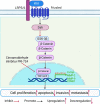Research progress in the mechanism and treatment of osteosarcoma
- PMID: 37649421
- PMCID: PMC10586865
- DOI: 10.1097/CM9.0000000000002800
Research progress in the mechanism and treatment of osteosarcoma
Abstract
Osteosarcoma (OS) is the most common primary malignant bone tumor that more commonly occurs in children and adolescents. The most commonly used treatment for OS is surgery combined with chemotherapy, but the treatment outcomes are typically unsatisfactory. High rates of metastasis and post-treatment recurrence rates are major challenges in the treatment of OS. This underlines the need for studying the in-depth characterization of the pathogenetic mechanisms of OS and development of more effective therapeutic modalities. Previous studies have demonstrated the important role of the bone microenvironment and the regulation of signaling pathways in the occurrence and development of OS. In this review, we discussed the available evidence pertaining to the mechanisms of OS development and identified therapeutic targets for OS. We also summarized the available treatment modalities for OS and identified future priorities for therapeutics research.
Copyright © 2023 The Chinese Medical Association, produced by Wolters Kluwer, Inc. under the CC-BY-NC-ND license.
Conflict of interest statement
None.
Figures






Similar articles
-
MAPK pathways regulation by DUSP1 in the development of osteosarcoma: Potential markers and therapeutic targets.Mol Carcinog. 2017 Jun;56(6):1630-1641. doi: 10.1002/mc.22619. Epub 2017 Feb 15. Mol Carcinog. 2017. PMID: 28112450
-
Innovative approaches for treatment of osteosarcoma.Exp Biol Med (Maywood). 2022 Feb;247(4):310-316. doi: 10.1177/15353702211067718. Epub 2022 Jan 19. Exp Biol Med (Maywood). 2022. PMID: 35043695 Free PMC article. Review.
-
Molecular Signaling Pathways as Potential Therapeutic Targets in Osteosarcoma.Curr Med Chem. 2022;29(25):4436-4444. doi: 10.2174/0929867329666220209110009. Curr Med Chem. 2022. PMID: 35139778 Review.
-
Present Advances and Future Perspectives of Molecular Targeted Therapy for Osteosarcoma.Int J Mol Sci. 2016 Apr 6;17(4):506. doi: 10.3390/ijms17040506. Int J Mol Sci. 2016. PMID: 27058531 Free PMC article. Review.
-
Autophagy and its role in osteosarcoma.Cancer Med. 2023 Mar;12(5):5676-5687. doi: 10.1002/cam4.5407. Epub 2023 Feb 15. Cancer Med. 2023. PMID: 36789748 Free PMC article. Review.
Cited by
-
Groenlandicine enhances cisplatin sensitivity in cisplatin-resistant osteosarcoma cells through the BAX/Bcl-2/Caspase-9/Caspase-3 pathway.J Bone Oncol. 2024 Aug 24;48:100631. doi: 10.1016/j.jbo.2024.100631. eCollection 2024 Oct. J Bone Oncol. 2024. PMID: 39263651 Free PMC article.
-
Unveiling the effects of GSK126 on osteosarcoma cells implications for apoptosis, autophagy, and cellular migration.Discov Oncol. 2025 Feb 27;16(1):245. doi: 10.1007/s12672-025-02010-7. Discov Oncol. 2025. PMID: 40014170 Free PMC article.
-
Gelatin-based biomaterials as a delivery strategy for osteosarcoma treatment.Front Pharmacol. 2025 Jan 28;16:1537695. doi: 10.3389/fphar.2025.1537695. eCollection 2025. Front Pharmacol. 2025. PMID: 39936088 Free PMC article. Review.
-
YB1 and its role in osteosarcoma: a review.Front Oncol. 2024 Oct 21;14:1452661. doi: 10.3389/fonc.2024.1452661. eCollection 2024. Front Oncol. 2024. PMID: 39497723 Free PMC article. Review.
-
DTX1 Modulates Microglial M1 Polarization and Exacerbates Neuroinflammation in Traumatic Brain Injury Model Rats through NF-κB/IRF5.Mol Neurobiol. 2025 Jul 15. doi: 10.1007/s12035-025-05200-0. Online ahead of print. Mol Neurobiol. 2025. PMID: 40660011
References
-
- Kager L, Tamamyan G, Bielack S. Novel insights and therapeutic interventions for pediatric osteosarcoma. Future Oncol 2017; 13: 357–368. doi: 10.2217/fon-2016-0261. - PubMed
Publication types
MeSH terms
LinkOut - more resources
Full Text Sources
Medical

